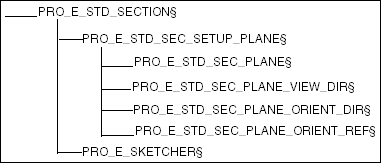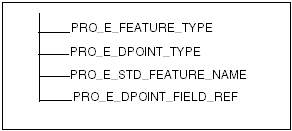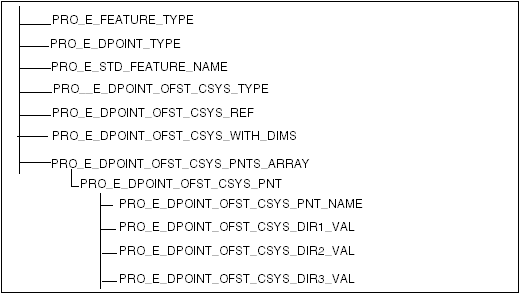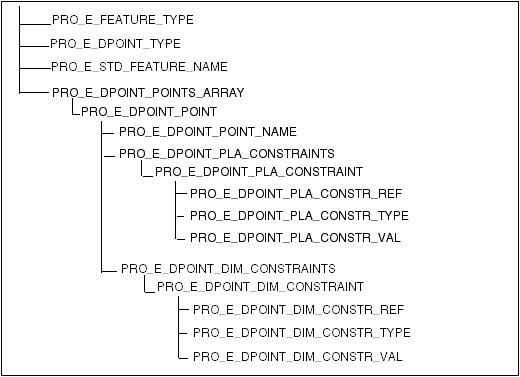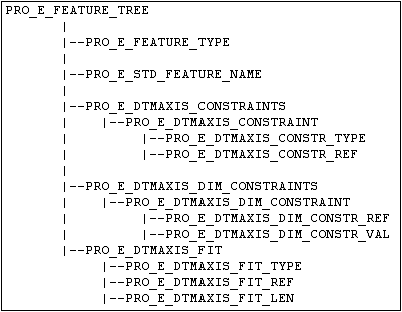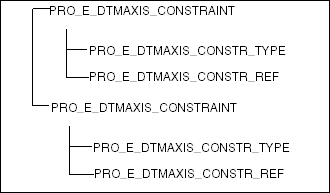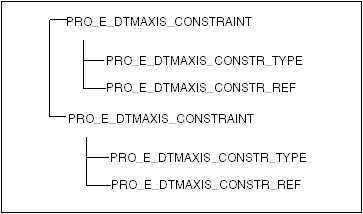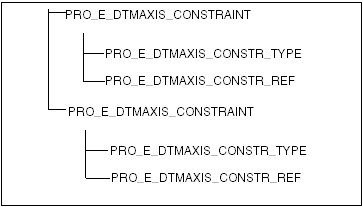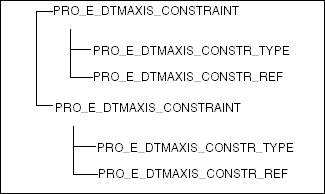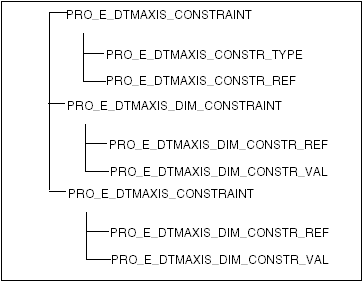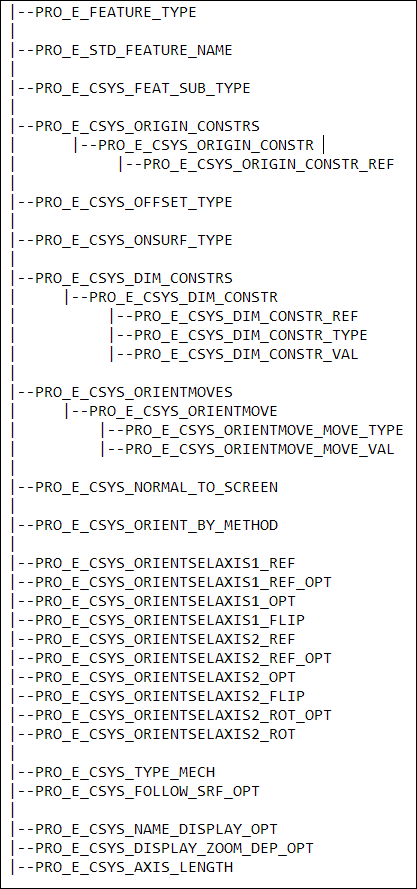Datum Plane Features
The element tree for a datum plane feature is documented in the header file ProDtmPln.h, and has a simple structure. Apart from the usual elements for the tree root and feature type, a datum plane contains the
positioning constraints, an optional flip direction, and an optional fit type.
The constraints element PRO_E_DTMPLN_CONSTRAINTS is an array element that contains a PRO_E_DTMPLN_CONSTRAINT element for each constraint. Many elements forming the constraint element PRO_E_DTMPLN_CONSTRAINT are used only for certain constraint types, so any given datum plane may contain fewer elements than are shown in the tree.
Similarly, all the elements forming the constraint element PRO_E_DTMPLN_FIT are not always essential.
The following figure shows the element tree for datum planes.

Many elements forming the constraint element PRO_E_DTMPLN_CONSTRAINT are used only for the following constraint types:
| • | PRO_E_DTMPLN_CONSTR_REF_OFFSET—Used if the constraint type is “offset.” |
| • | PRO_E_DTMPLN_CONSTR_REF_ANGLE—Used if the constraint type is “angle.” |
| • | PRO_E_DTMPLN_CONSTR_SEC_IND—Used if the constraint type is “section.” |
| • | PRO_E_DTMPLN_OFF_CSYS—Used if the constraint type is “offset” and the reference is “Csys.” |
| • | PRO_E_DTMPLN_OFF_CSYS_OFFSET—Used if the constraint type is “offset” and the reference is “Csys.” |
Similarly, elements of the optional element PRO_E_DTMPLN_FIT are used for the following fit types:
| • | PRO_E_DTMPN_FIT_REF—Used if the fit type is not “default” or “fit.” |
| • | PRO_E_DTMPLN_FIT_DIM_RAD—Used if the fit type is “fit radius.” |
The following table describes the tree elements in detail:
|
Element ID
|
Element Name
|
Data Type
|
Valid Value
|
|---|---|---|---|
|
PRO_E_FEATURE_TYPE
|
Feature type
|
PRO_VALUE_TYPE_INT
|
PRO_FEAT_DATUM
|
|
PRO_E_STD_FEATURE_NAME
|
Feature Name
|
PRO_VALUE_TYPE
_WSTRING |
|
|
PRO_E_DTMPLN_CONSTRAINTS
|
Constraints
|
Array
|
|
|
PRO_E_DTMPLN_CONSTRAINT
|
Constraints
|
Compound
|
|
|
PRO_E_DTMPLN_CONSTR_TYPE
|
Type
|
PRO_VALUE_TYPE_INT
|
See ProDtmplnConstrType
|
|
PRO_E_DTMPLN_CONSTR_REF
|
References
|
PRO_VALUE_TYPE_SELECTION
|
|
|
PRO_E_DTMPLN_CONSTR_REF_OFFSET
|
Offset
|
PRO_VALUE_TYPE
_DOUBLE |
Any
|
|
PRO_E_DTMPLN_CONSTR_REF_ANGLE
|
Angle
|
PRO_VALUE_TYPE
_DOUBLE |
(-360.0, 360.0)
|
|
PRO_E_DTMPLN_SEC_IND
|
Section index
|
PRO_VALUE_TYPE_INT
|
[0, sec num - 1]
|
|
PRO_E_DTMPLN_OFF_CSYS
|
Offset coordinate system
|
PRO_VALUE_TYPE_INT
|
See ProDtmplnOffCsysAxis
|
|
PRO_E_DTMPLN_OFF_CSYS_OFFSET
|
Offset coordinate system value
|
PRO_VALUE_TYPE
_DOUBLE |
Any
|
|
PRO_E_DTMPLN_FLIP_DIR
|
Flip direction
|
PRO_VALUE_TYPE_INT
|
ProDtmplnFlipDir
|
|
PRO_E_DTMPLN_FIT
|
Fit
|
Compound
|
|
|
PRO_E_DTMPLN_FIT_TYPE
|
Fit type
|
PRO_VALUE_TYPE_INT
|
ProDtmplnFitType
|
|
PRO_E_DTMPLN_FIT_REF
|
Reference
|
PRO_VALUE_TYPE_SELECTION
|
|
|
PRO_E_DTMPLN_FIT_DTM_RAD
|
Datum radius
|
PRO_VALUE_TYPE_
DOUBLE |
>= 0.0
|
Constraint Reference Types
The following table does not describe the entire list of combinations of geometrical constraints that can be applied, or the
rules for what geometry items they can refer to. These are partially documented in Note 1 of the elements table in ProDtmPln.h, which includes the following information:
|
Constraint Type
|
Valid Reference Types
|
|---|---|
|
PRO_DTMPLN_THRU
|
PRO_AXIS, PRO_EDGE, PRO_CURVE, Channel, PRO_POINT, PRO_EDGE_START, PRO_EDGE_END, PRO_CRV_START, PRO_CRV_END, PRO_SURFACE (Plane, Cylinder)
|
|
PRO_DTMPLN_NORM
|
PRO_AXIS, PRO_EDGE, PRO_CURVE, Channel PRO_SURFACE (plane)
|
|
PRO_DTMPLN_PRL
|
PRO_SURFACE (plane)
|
|
PRO_DTMPLN_OFFS
|
PRO_SURFACE (plane), PRO_CSYS
|
|
PRO_DTMPLN_ANG
|
PRO_SURFACE (plane)
|
|
PRO_DTMPLN_TANG
|
PRO_SURFACE (cylinder)
|
|
PRO_DTMPLN_SEC
|
PRO_FEATURE (blend)
|
|
PRO_DTMPLN_DEF_X
|
No reference needed
|
|
PRO_DTMPLN_DEF_Y
|
No reference needed
|
|
PRO_DTMPLN_DEF_Z
|
No reference needed
|
|
PRO_DTMPLN_THRU_CSYS_XY
|
PRO_CSYS
|
|
PRO_DTMPLN_THRU_CSYS_YZ
|
PRO_CSYS
|
|
PRO_DTMPLN_THRU_CSYS_ZX
|
PRO_CSYS
|
|
PRO_DTMPLN_MIDPLN
|
Planar reference type: PRO_SURFACE
Linear reference types: PRO_AXIS, PRO_EDGE, PRO_CURVE
Point reference types: PRO_POINT, PRO_EDGE_START, PRO_EDGE_END, PRO_CRV_START, PRO_CRV_END
|
|
PRO_DTMPLN_BISECTOR1
|
Planar reference type: PRO_SURFACE
Linear reference types: PRO_AXIS, PRO_EDGE, PRO_CURVE
|
|
PRO_DTMPLN_BISECTOR2
|
Planar reference type: PRO_SURFACE
Linear reference types: PRO_AXIS, PRO_EDGE, PRO_CURVE
|
Note
For constraint type PRO_DTMPLN_TANG, there can be two tangents to a cylindrical surface passing through a single point. Specify a point on the cylindrical surface
so that the tangent plane is created through this point or a point nearer to this specified point keeping the tangency condition.
See Creo Parametric online help on datum planes for a detailed description of the valid constraint combinations and references.
Fit Reference Types
The following table describes the corresponding rules for the fit options in detail:
|
Fit Type
|
Valid Reference Types
|
|---|---|
|
PRO_DTMPLN_FIT_DEFAULT
|
—
|
|
PRO_DTMPLN_FIT_PART
|
PRO_PART
|
|
PRO_DTMPLN_FIT_FEATURE
|
PRO_FEATURE
|
|
PRO_DTMPLN_FIT_SURFACE
|
PRO_SURFACE
|
|
PRO_DTMPLN_FIT_EDGE
|
PRO_EDGE
|
|
PRO_DTMPLN_FIT_AXIS
|
PRO_AXIS
|
|
PRO_DTMPLN_FIT_RADIUS
|
—
|
|
PRO_DTMPLN_FIT_POINT
|
PRO_POINT
|
Example 1: Creating a Datum Plane
The sample code in the file UgDatumCreate.c located at <creo_toolkit_loadpoint>/protk_appls/pt_userguide/ptu_datum shows how to create a datum plane that is offset from the specified plane. The user selects the reference plane and supplies
the offset.
Examples
Example 1: Through a Plane
The element tree structure of a plane through a plane or planar surface is shown in the following figure:


The following table specifies the element tree constraints for this type:
|
Placement Constraint Element
|
Placement Constraint Member Elements
|
Valid Value
|
|---|---|---|
|
PRO_E_DTMPLN_CONSTRAINT (Constraint 1)
|
PRO_E_DTMPLN_CONSTR_TYPE
|
PRO_DTMPLN_THRU
|
|
PRO_E_DTMPLN_CONSTR_REF
|
PRO_SURFACE (Plane)
|
Example 2: Offset to a Plane
The element tree structure of a plane offset to a plane or to a planar surface is shown in the following figure.
 The following table specifies the element tree constraints for this type.
The following table specifies the element tree constraints for this type.

|
Placement Constraint Element
|
Placement Constraint Member Elements
|
Valid Value
|
|---|---|---|
|
PRO_E_DTMPLN_CONSTRAINT (Constraint 1)
|
PRO_E_DTMPLN_CONSTR_TYPE
|
PRO_DTMPLN_OFFS
|
|
PRO_E_DTMPLN_CONSTR_REF
|
PRO_SURFACE (Plane)
|
|
|
PRO_E_DTMPLN_CONSTR_REF_OFFSET
|
Offset value
|
Example 3: Offset along a Csys Axis
The element tree structure of a plane offset along the coordinate system axis is shown in the following figure.
 The following table specifies the element tree constraints for this type.
The following table specifies the element tree constraints for this type.

|
Placement Constraint Element
|
Placement Constraint Member Elements
|
Valid Value
|
|---|---|---|
|
PRO_E_DTMPLN_CONSTRAINT (Constraint 1)
|
PRO_E_DTMPLN_CONSTR_TYPE
|
PRO_E_DTMPLN_OFF_CSYS_OFFSET
|
|
PRO_E_DTMPLN_CONSTR_REF
|
PRO_CSYS
|
|
|
PRO_E_DTMPLN_OFF_CSYS
|
PRO_DTMPLN_OFF_CSYS_X or PRO_DTMPLN_OFF_CSYS_Y or PRO_DTMPLN_OFF_CSYS_Z
|
|
|
PRO_E_DTMPLN_OFF_CSYS_OFFSET
|
Offset value
|
Example 4 : Through a Csys Plane
The element tree structure of a plane passing through a coordinate system plane (XY/YZ/ZX) is shown in the following figure.
 The following table specifies the element tree constraints for this type.
The following table specifies the element tree constraints for this type.

|
Placement Constraint Element
|
Placement Constraint Member Elements
|
Valid Value
|
|---|---|---|
|
PRO_E_DTMPLN_CONSTRAINT (Constraint 1)
|
PRO_E_DTMPLN_CONSTR_TYPE
|
PRO_DTMPLN_THRU_CSYS_XY or PRO_DTMPLN_THRU_CSYS_YZ or PRO_DTMPLN_THRU_CSYS_ZX
|
|
PRO_E_DTMPLN_CONSTR_REF
|
PRO_CSYS
|
Example 5: Parallel to a Plane and Through a Point
The element tree structure of a plane parallel to a plane or a planar surface and passing through a point is shown in the
following figure.
 The following table specifies the element tree constraints for this type.
The following table specifies the element tree constraints for this type.

|
Placement Constraint Element
|
Placement Constraint Member Elements
|
Valid Value
|
|---|---|---|
|
PRO_E_DTMPLN_CONSTRAINT (Constraint 1)
|
PRO_E_DTMPLN_CONSTR_TYPE
|
PRO_DTMPLN_PRL
|
|
PRO_E_DTMPLN_CONSTR_REF
|
PRO_SURFACE (Plane)
|
|
|
PRO_E_DTMPLN_CONSTRAINT (Constraint 2)
|
PRO_E_DTMPLN_CONSTR_TYPE
|
PRO_DTMPLN_THRU
|
|
PRO_E_DTMPLN_CONSTR_REF
|
PRO_POINT,PRO_EDGE_START,
PRO_EDGE_END, PRO_CRV_START,PRO_CRV_END |
Example 6 : Through an Axis and Angle to a Plane
The element tree structure of a plane passing through an axis and at an angle to a plane is shown in the following figure.
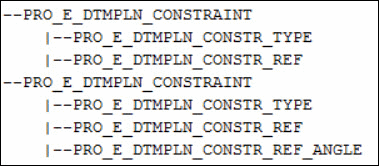 The following table specifies the element tree constraints for this type.
The following table specifies the element tree constraints for this type.

|
Placement Constraint Element
|
Placement Constraint Member Elements
|
Valid Value
|
|---|---|---|
|
PRO_E_DTMPLN_CONSTRAINT (Constraint 1)
|
PRO_E_DTMPLN_CONSTR_TYPE
|
PRO_DTMPLN_THRU
|
|
PRO_E_DTMPLN_CONSTR_REF
|
PRO_AXIS, PRO_CURVE (STRAIGHT), PRO_EDGE (STRAIGHT)
|
|
|
PRO_E_DTMPLN_CONSTRAINT (Constraint 2)
|
PRO_E_DTMPLN_CONSTR_TYPE
|
PRO_DTMPLN_ANG
|
|
PRO_E_DTMPLN_CONSTR_REF
|
PRO_SURFACE (Plane),
|
|
|
PRO_E_DTMPLN_CONSTR_REF_ANGLE
|
Angle value (-360.0, 360.0)
|
Example 7: Through a Linear Reference (Axis, Inferred Axis, Straight Edge or Curve) and a Point
The element tree structure of a plane passing through an axis or an inferred axis and a point is shown in the following figure.
An inferred axis is the axis of a surface of revolution like, Cylinder, Cone, Sphere, Torus or any other general surface of
revolution.
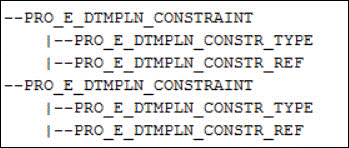 The following table specifies the element tree constraints for this type.
The following table specifies the element tree constraints for this type.

|
Placement Constraint Element
|
Placement Constraint Member Elements
|
Valid Value
|
|---|---|---|
|
PRO_E_DTMPLN_CONSTRAINT (Constraint 1)
|
PRO_E_DTMPLN_CONSTR_TYPE
|
PRO_DTMPLN_THRU
|
|
PRO_E_DTMPLN_CONSTR_REF
|
PRO_AXIS, PRO_CURVE (STRAIGHT), PRO_EDGE (STRAIGHT, PRO_SURFACE(CYLINDER/CONE/SPHERE/TORUS/General surface of revolution)
|
|
|
PRO_E_DTMPLN_CONSTRAINT (Constraint 2)
|
PRO_E_DTMPLN_CONSTR_TYPE
|
PRO_DTMPLN_THRU
|
|
PRO_E_DTMPLN_CONSTR_REF
|
PRO_POINT, PRO_EDGE_START, PRO_EDGE_END, PRO_CRV_START, PRO_CRV_END
|
Example 8: Normal to a Linear Reference (Axis, Inferred Axis, Straight Edge or Curve) and a Point
The element tree structure of a plane normal to an axis or inferred axis and passing through a point is shown in the following
figure.
 The following table specifies the element tree constraints for this type.
The following table specifies the element tree constraints for this type.

|
Placement Constraint Element
|
Placement Constraint Member Elements
|
Valid Value
|
|---|---|---|
|
PRO_E_DTMPLN_CONSTRAINT (Constraint 1)
|
PRO_E_DTMPLN_CONSTR_TYPE
|
PRO_DTMPLN_NORM
|
|
PRO_E_DTMPLN_CONSTR_REF
|
PRO_AXIS, PRO_CURVE (STRAIGHT), PRO_EDGE (STRAIGHT), PRO_SURFACE(CYLINDER/CONE/SPHERE/TORUS/
General surface of revolution) |
|
|
PRO_E_DTMPLN_CONSTRAINT (Constraint 2)
|
PRO_E_DTMPLN_CONSTR_TYPE
|
PRO_DTMPLN_THRU
|
|
PRO_E_DTMPLN_CONSTR_REF
|
PRO_POINT, PRO_EDGE_START, PRO_EDGE_END, PRO_CRV_START, PRO_CRV_END
|
Example 9: Midplane to a Plane and Parallel to Another Plane
The element tree structure of a midplane to a plane or a planar surface and parallel to another plane or planar surface, when
these two references are parallel, is shown in the following figure.
 The following table specifies the element tree constraints for this type.
The following table specifies the element tree constraints for this type.

|
Placement Constraint Element
|
Placement Constraint Member Elements
|
Valid Value
|
|---|---|---|
|
PRO_E_DTMPLN_CONSTRAINT (Constraint 1)
|
PRO_E_DTMPLN_CONSTR_TYPE
|
PRO_DTMPLN_MIDPLN
|
|
PRO_E_DTMPLN_CONSTR_REF
|
PRO_SURFACE (Plane)
|
|
|
PRO_E_DTMPLN_CONSTRAINT (Constraint 2)
|
PRO_E_DTMPLN_CONSTR_TYPE
|
PRO_DTMPLN_PRL
|
|
PRO_E_DTMPLN_CONSTR_REF
|
PRO_SURFACE (Plane)
|
Example 10: Midplane to a Plane and at an Angle to Another Plane
The element tree structure of a midplane to a plane or a planar surface and angular to another plane or planar surface, when
these two references are intersecting, is shown in the following figure.
 The following table specifies the element tree constraints for this type.
The following table specifies the element tree constraints for this type.

|
Placement Constraint Element
|
Placement Constraint Member Elements
|
Valid Value
|
|---|---|---|
|
PRO_E_DTMPLN_CONSTRAINT (Constraint 1)
|
PRO_E_DTMPLN_CONSTR_TYPE
|
PRO_DTMPLN_MIDPLN
|
|
PRO_E_DTMPLN_CONSTR_REF
|
PRO_SURFACE (Plane)
|
|
|
PRO_E_DTMPLN_CONSTRAINT (Constraint 2)
|
PRO_E_DTMPLN_CONSTR_TYPE
|
PRO_DTMPLN_BISECTOR1
PRO_DTMPLN_BISECTOR2
|
|
PRO_E_DTMPLN_CONSTR_REF
|
PRO_SURFACE (Plane)
|
Example 11: Midplane to a Plane and Midplane to a Point
The element tree structure of a midplane to a plane or a planar surface and midplane to a point, where the point does not
lie on the plane, is shown in the following figure.
 The following table specifies the element tree constraints for this type.
The following table specifies the element tree constraints for this type.

|
Placement Constraint Element
|
Placement Constraint Member Elements
|
Valid Value
|
|---|---|---|
|
PRO_E_DTMPLN_CONSTRAINT (Constraint 1)
|
PRO_E_DTMPLN_CONSTR_TYPE
|
PRO_DTMPLN_MIDPLN
|
|
PRO_E_DTMPLN_CONSTR_REF
|
PRO_SURFACE (Plane)
|
|
|
PRO_E_DTMPLN_CONSTRAINT (Constraint 2)
|
PRO_E_DTMPLN_CONSTR_TYPE
|
PRO_DTMPLN_MIDPLN
|
|
PRO_E_DTMPLN_CONSTR_REF
|
PRO_POINT,
PRO_EDGE_START,
PRO_EDGE_END,
PRO_CRV_START,
PRO_CRV_END
|
Example 12: Through Three Points
The element tree structure of a plane passing through three non-collinear points is shown in the following figure.
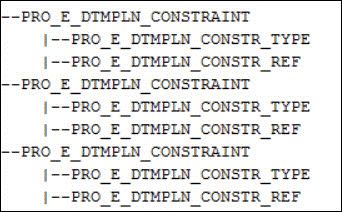 The following table specifies the element tree constraints for this type.
The following table specifies the element tree constraints for this type.

|
Placement Constraint Element
|
Placement Constraint Member Elements
|
Valid Value
|
|---|---|---|
|
PRO_E_DTMPLN_CONSTRAINT (Constraint 1)
|
PRO_E_DTMPLN_CONSTR_TYPE
|
PRO_DTMPLN_THRU
|
|
PRO_E_DTMPLN_CONSTR_REF
|
PRO_POINT, PRO_EDGE_START,
PRO_EDGE_END, PRO_CRV_START,PRO_CRV_END |
|
|
PRO_E_DTMPLN_CONSTRAINT (Constraint 2)
|
PRO_E_DTMPLN_CONSTR_TYPE
|
PRO_DTMPLN_THRU
|
|
PRO_E_DTMPLN_CONSTR_REF
|
PRO_POINT, PRO_EDGE_START, PRO_EDGE_END, PRO_CRV_START, PRO_CRV_END
|
|
|
PRO_E_DTMPLN_CONSTRAINT (Constraint 3)
|
PRO_E_DTMPLN_CONSTR_TYPE
|
PRO_DTMPLN_THRU
|
|
PRO_E_DTMPLN_CONSTR_REF
|
PRO_POINT, PRO_EDGE_START, PRO_EDGE_END, PRO_CRV_START, PRO_CRV_END
|
Example 13: To Flip Direction
The datum plane normal that is the Z-direction can be flipped for any of the types. The following table specifies the element
tree to flip the plane.
|
Element ID
|
Valid Value
|
|---|---|
|
PRO_E_DTMPLN_FLIP_DIR
|
PRO_DTMPLN_FLIP_DIR_NO or PRO_DTMPLN_FLIP_DIR_YES
|
Example 14: To Fit Outline to a Reference
The datum plane outline can be fit to a reference. The following figure shows the element tree structure using the fit elements.
 The following table specifies the element tree to use fit elements.
The following table specifies the element tree to use fit elements.

|
Fit Compound Element
|
Fit Member Elements
|
Valid Value
|
|---|---|---|
|
PRO_E_DTMPLN_FIT
|
PRO_E_DTMPLN_FIT _TYPE
|
PRO_DTMPLN_FIT_PART
|
|
PRO_E_DTMPLN_FIT _REF
|
PRO_PART
|

